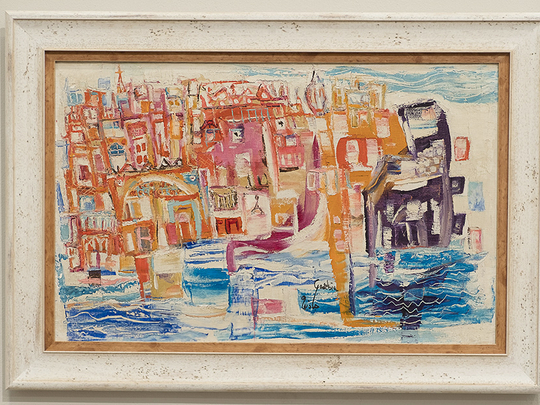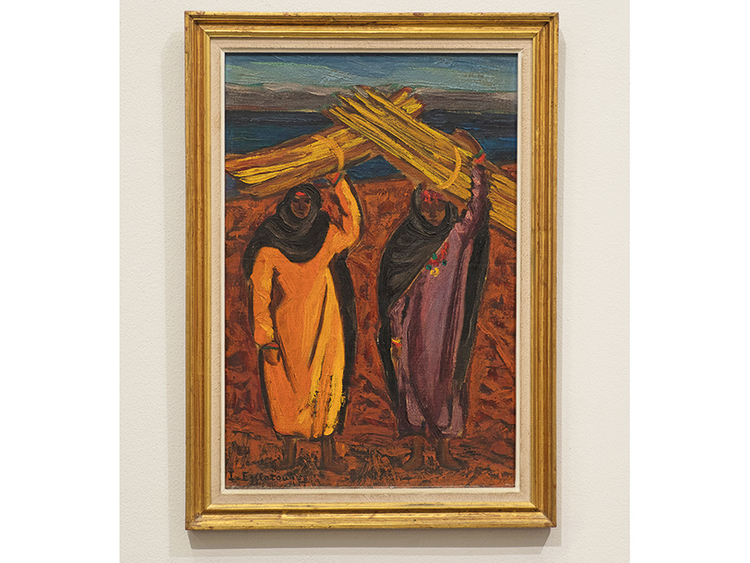
Green Art Gallery’s latest exhibition, Modernist Women of Egypt, highlights the role of women artists in the development of modern art in Egypt. The museum quality show features paintings by acclaimed artists Inji Efflatoun, Vessela Farid, Tahia Halim, Zeinab Abdel Hamid, Effat Naghi, Marguerite Nakhla, Gazbia Sirry, and Margo Veillon. The show focuses on the period between the 1950s and early 1970s, reflecting how the country’s socio-political environment in the early 20th century fostered the development of women artists.
Modern art in Egypt flourished after the opening of the Egyptian School of Fine Arts in 1908. The country was under British colonial rule then, and artists played a prominent role in the revolutionary social, cultural and political changes that led to independence from colonial rule in 1952, and the subsequent process of nation building and development of a national identity.
Egyptian women became involved in the public discourse during this wave of nationalism and period of cultural awakening. Activists such as Huda Shaarawi, Nabawiyya Musa and Doria Shafik led a strong women’s movement that fought for women’s rights in the private and public sphere and led to the passing of various laws in the 1950s that improved the status of women in Egyptian society, including giving them the right to vote.
Mahmoud Mukhtar, a pioneer of Egyptian modernism expressed how important the freedom of women from the shackles of tradition was in shaping a new Egyptian identity, through his 1928 public sculpture ‘Nahdat Misr’ (Egyptian Renaissance), depicting a young peasant woman removing her veil, while standing beside the Sphinx.
Women artists played a significant role in these feminist and nationalist movements, using their art to raise social and political consciousness. Efflatoun exhibited her work with the Art and Freedom Group, which used Surrealism to fight against Fascism and the use of art in political propaganda; and Sirry played a key role in the development of the Group of Modern Art, that used new visual symbols to speak about independence and social justice.
The hope and national pride felt by Egyptians after independence was also reflected in the art of the time. Moving away from Western themes, artists began to portray the men and women who participated in the revolution, the daily lives of the peasants (fellahin) in the country side and industrial workers involved in rebuilding the nation, and Egyptian mythology and folklore, to create authentic Egyptian imagery, and to speak about the struggles and aspirations of ordinary Egyptians.
The paintings in this show reflect these themes, while emphasising the changing role of women in society and politics. The show thus speaks about the evolution of the history of modern Egypt through the voices of women who participated in and witnessed the changes. It celebrates the legacies of these important women artists, who came from different social backgrounds and developed unique vocabularies to express their feelings and experiences during an eventful period in Egyptian history and art.
Efflatoun (1924-1989) was a political activist who fought for the rights of the underprivileged, especially women, in public life and in her paintings. She focused on subjects such as the fellahin in the countryside, construction workers, freedom fighters, and the struggles of Egyptian women from different social strata. She also wrote two books about feminist movements in Egypt and in the West, and her radical views even led to her being imprisoned in 1959. Her paintings in the show depict ordinary people such as dyers, fishermen, and peasant women collecting firewood, or making bread. The dark palette she has used highlights the grim conditions they lived and worked in.
Farid’s (1915-2007) paintings of Egyptian women in traditional attire offered a glimpse into the inner circles of women who were struggling with poverty, as illustrated by her gloomy painting of a young woman featured in this show.
Halim (1919-2003) expressed her nationalist fervour by painting scenes from everyday life in Egypt, and themes inspired by Egyptian folklore. She was especially interested in Nubian culture, and often painted Nubian women in scenes from their daily lives. She is represented in the show through paintings of the marketplace in Nubia, and a striking oil and gold leaf painting of a Nubian woman.
Hamid’s (1919-2002) paintings depicted the changing rural and urban landscape in her country, and everyday scenes from the streets, traditional coffee houses and market squares. Her painting featured in the show is a beautiful illustration of a typical day in a village.
Naghi (1905-1994) was a collector of local folk artefacts. She used these symbolic objects to create assemblages that explored Egyptian culture, to get Egyptians back in touch with their roots at a time when a new Egyptian identity was being forged. The show includes three significant works by the artist.
Her Coptic upbringing, local folklore, and rural life were the main inspirations for Nakhla (1908-1977). She used satire to criticise Egypt’s political and economic agenda, as seen in her dark, untitled watercolour painting of farmers and domestic animals in the fields, displayed in this exhibition.
Sirry, who was born in 1925 and has taught art at Helwan University and the American University of Cairo, expresses her long term commitment to issues of feminism, gender politics, nationalist struggles, and political freedom, in a visual language that is truly, modern Egyptian, as illustrated in her bold paintings in the show.
Austrian-Swiss artist Veillon (1907-2003) was born in Cairo and contributed to the Egyptian art scene by running an atelier that trained many women artists. She was fascinated by the Egyptian landscape and the country’s multicultural society, and spent years in various parts of the country observing local customs and the daily lives of the people, which she depicted in her paintings. Her distinct, expressive style can be seen in several paintings on display at the show.
Jyoti Kalsi is an arts-enthusiast based in Dubai.
Modernist Women of Egypt will run at the Green Art Gallery, Alserkal Avenue until July 27













